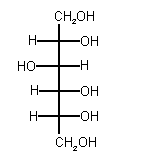Enhanced TDS
Knowde-enriched technical product data sheet
Identification & Functionality
- Ingredient Name
- Food Ingredients Functions
- Ingredients
- Sorbitol
- Food Additive Number
- E 420(i), INS 420(i)
- Technologies
- Product Families
- Molecular Structure

- Product Information
- Division: Starch
- Plant locations: Himmatnagar, Sitarganj, Chalisgaon
Features & Benefits
- Food Ingredients Features
Applications & Uses
- Markets
- Applications
- Food & Nutrition Applications
- Applications
- In sugar free candy manufacture, sorbitol finds it application as a sugar free reduced-calorie sweetener. It improves the candy’s softness and chewy texture.
- In sugar free ice cream, it is usually used to provide sweetness, impart body and texture.
- In Diabetic fruit jam and peanut butter, sorbitol is used as a humectant to reduce dryness and improve spreadability.
- Textile and Leather Application: Sorbitol is usually used as a dispensing agent, humectant/bodying agent, and sequestering agent. It is used as a color stabilizer in textile printing, as a humectant in textile sizing, and as a softener in finishing.
- Emulsion Products:Sorbitol retards the loss of water by evaporation from oil in oil/water emulsions.
- Tobacco Industry:Sorbitol is used to contribute to the flavor of chewing tobacco and used as humectant and conditioner
- Adhesives Applications:The characteristics of sorbitol that it neither loses nor absorbs any appreciable quantity of water increases the viscosity of the glues composition, and its non-volatility are an advantage in adhesive applications.
- Pharmaceuticals Industry:As a good humectant and plasticizer sorbitol is usually used in emulsion ointments and in gelatine capsules. It is also finds uses in pharmaceutical syrups where it’s stability, non-cariogenicity and viscosity are an advantage. Sorbitol is also used medically in culture mediums to distinguish between various strains of bacteria such as E coli.
- Others IndustriesSorbitol is used to make polyurethane foams with specific strength and absorbency which finds uses in, for instance, vehicle dashboards. It is also used as a chelator in metal working and is used in processes to anodize aluminum
Properties
- Appearance
- A clear colourless viscous liquid
- Taste
- Mild Sweet
- Typical Properties
Value Units Test Method / Conditions Total capacity 310.0 MT/Day - Specific gravity at 25°C min. 1.290 - - Refractive Index at 20°C 1.457 to 1.462 - - Acidity (Of 0.05M Sodium thiosulphate solution should be consumed as per specified test in I.P) min. 12.8 ml - Optical Rotation (As per specified test in I.P.) 0° - +1.5° - - Clarity & Colour Clean and colourless - - Arsenic min. 2 ppm - Heavy Metals min. 10 ppm - Chloride min. 50 ppm - Sulphate min. 125 ppm - Nickel Content min. 1 ppm - Sulphated Ash min. 0.1 % w/w - Solid Matter 69 - 71 % w/w - Polyols 68 - 72 % w/w -
Packaging & Availability
- Packaging
In 300 kg HM HDPE barrels, 1 MT IBC and in ISO Tanks
Storage & Handling
- Shelf Life
3 years from Production Date